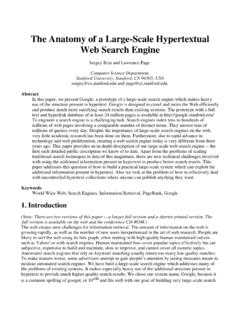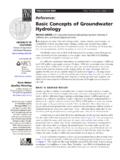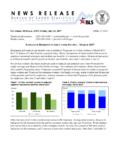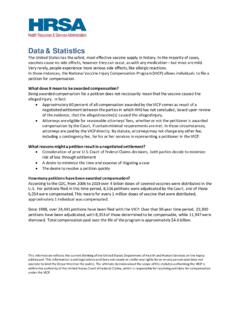Transcription of Learning Transferable Architectures for Scalable Image ...
1 Learning Transferable Architectures for Scalable Image Recognition Barret Zoph Vijay Vasudevan Jonathon Shlens Quoc V. Le Google Brain Google Brain Google Brain Google Brain [ ] 11 Apr 2018. Abstract 1. Introduction Developing neural network Image classification models often requires significant architecture engineering. Starting Developing neural network Image classification models from the seminal work of [32] on using convolutional archi- often requires significant architecture engineering. In this tectures [17, 34] for ImageNet [11] classification, succes- paper, we study a method to learn the model Architectures sive advancements through architecture engineering have directly on the dataset of interest. As this approach is ex- achieved impressive results [53, 59, 20, 60, 58, 68]. pensive when the dataset is large, we propose to search for In this paper, we study a new paradigm of designing con- an architectural building block on a small dataset and then volutional Architectures and describe a Scalable method to transfer the block to a larger dataset.
2 The key contribu- optimize convolutional Architectures on a dataset of inter- tion of this work is the design of a new search space (which est, for instance the ImageNet classification dataset. Our we call the NASNet search space ) which enables trans- approach is inspired by the recently proposed Neural Ar- ferability. In our experiments, we search for the best con- chitecture Search (NAS) framework [71], which uses a re- volutional layer (or cell ) on the CIFAR-10 dataset and inforcement Learning search method to optimize architec- then apply this cell to the ImageNet dataset by stacking to- ture configurations. Applying NAS, or any other search gether more copies of this cell, each with their own parame- methods, directly to a large dataset, such as the ImageNet ters to design a convolutional architecture, which we name dataset, is however computationally expensive.
3 We there- a NASNet architecture . We also introduce a new regu- fore propose to search for a good architecture on a proxy larization technique called ScheduledDropPath that signif- dataset, for example the smaller CIFAR-10 dataset, and then icantly improves generalization in the NASNet models. On transfer the learned architecture to ImageNet. We achieve CIFAR-10 itself, a NASNet found by our method achieves this transferrability by designing a search space (which we error rate, which is state-of-the-art. Although the cell call the NASNet search space ) so that the complexity of is not searched for directly on ImageNet, a NASNet con- the architecture is independent of the depth of the network structed from the best cell achieves, among the published and the size of input images. More concretely, all convolu- works, state-of-the-art accuracy of top-1 and tional networks in our search space are composed of convo- top-5 on ImageNet.
4 Our model is better in top-1 accu- lutional layers (or cells ) with identical structure but dif- racy than the best human-invented Architectures while hav- ferent weights. Searching for the best convolutional archi- ing 9 billion fewer FLOPS a reduction of 28% in compu- tectures is therefore reduced to searching for the best cell tational demand from the previous state-of-the-art model. structure. Searching for the best cell structure has two main When evaluated at different levels of computational cost, benefits: it is much faster than searching for an entire net- accuracies of NASNets exceed those of the state-of-the-art work architecture and the cell itself is more likely to gener- human-designed models. For instance, a small version of alize to other problems. In our experiments, this approach NASNet also achieves 74% top-1 accuracy, which is significantly accelerates the search for the best Architectures better than equivalently-sized, state-of-the-art models for using CIFAR-10 by a factor of 7 and learns Architectures mobile platforms.
5 Finally, the Image features learned from that successfully transfer to ImageNet. Image classification are generically useful and can be trans- Our main result is that the best architecture found on ferred to other computer vision problems. On the task of ob- CIFAR-10, called NASNet, achieves state-of-the-art ac- ject detection, the learned features by NASNet used with the curacy when transferred to ImageNet classification with- Faster-RCNN framework surpass state-of-the-art by out much modification. On ImageNet, NASNet achieves, achieving mAP on the COCO dataset. among the published works, state-of-the-art accuracy of top-1 and top-5. This result amounts to a 1. improvement in top-1 accuracy than the best human- 3. Method invented Architectures while having 9 billion fewer FLOPS. On CIFAR-10 itself, NASNet achieves error rate, Our work makes use of search methods to find good con- which is also state-of-the-art.
6 Volutional Architectures on a dataset of interest. The main search method we use in this work is the Neural Architec- Additionally, by simply varying the number of the con- ture Search (NAS) framework proposed by [71]. In NAS, volutional cells and number of filters in the convolutional a controller recurrent neural network (RNN) samples child cells, we can create different versions of NASNets with dif- networks with different Architectures . The child networks ferent computational demands. Thanks to this property of are trained to convergence to obtain some accuracy on a the cells, we can generate a family of models that achieve held-out validation set. The resulting accuracies are used accuracies superior to all human-invented models at equiv- to update the controller so that the controller will generate alent or smaller computational budgets [60, 29].
7 Notably, better Architectures over time. The controller weights are the smallest version of NASNet achieves top-1 ac- updated with policy gradient (see Figure 1). curacy on ImageNet, which is better than previously engineered Architectures targeted towards mobile and em- Sample architecture A! bedded vision tasks [24, 70]. with probability p Finally, we show that the Image features learned by NASNets are generically useful and transfer to other com- Train a child network! with architecture A to ! puter vision problems. In our experiments, the features The controller (RNN). convergence to get ! learned by NASNets from ImageNet classification can be validation accuracy R. combined with the Faster-RCNN framework [47] to achieve state-of-the-art on COCO object detection task for both the Scale gradient of p by R! largest as well as mobile-optimized models.
8 Our largest to update the controller NASNet model achieves mAP, which is 4% better than previous state-of-the-art. Figure 1. Overview of Neural Architecture Search [71]. A con- troller RNN predicts architecture A from a search space with prob- ability p. A child network with architecture A is trained to con- vergence achieving accuracy R. Scale the gradients of p by R to 2. Related Work update the RNN controller. The proposed method is related to previous work in hy- perparameter optimization [44, 4, 5, 54, 55, 6, 40] es- The main contribution of this work is the design of a pecially recent approaches in designing Architectures such novel search space, such that the best architecture found as Neural Fabrics [48], DiffRNN [41], MetaQNN [3] and on the CIFAR-10 dataset would scale to larger, higher- DeepArchitect [43]. A more flexible class of methods for resolution Image datasets across a range of computational designing architecture is evolutionary algorithms [65, 16, settings.]
9 We name this search space the NASNet search 57, 30, 46, 42, 67], yet they have not had as much success space as it gives rise to NASNet, the best architecture found at large scale. Xie and Yuille [67] also transferred learned in our experiments. One inspiration for the NASNet search Architectures from CIFAR-10 to ImageNet but performance space is the realization that architecture engineering with of these models (top-1 accuracy ) are notably below CNNs often identifies repeated motifs consisting of com- previous state-of-the-art (Table 2). binations of convolutional filter banks, nonlinearities and a The concept of having one neural network interact with a prudent selection of connections to achieve state-of-the-art second neural network to aid the Learning process, or learn- results (such as the repeated modules present in the Incep- ing to learn or meta- Learning [23, 49] has attracted much tion and ResNet models [59, 20, 60, 58]).
10 These observa- attention in recent years [1, 62, 14, 19, 35, 45, 15]. Most tions suggest that it may be possible for the controller RNN. of these approaches have not been scaled to large problems to predict a generic convolutional cell expressed in terms of like ImageNet. An exception is the recent work focused these motifs. This cell can then be stacked in series to han- on Learning an optimizer for ImageNet classification that dle inputs of arbitrary spatial dimensions and filter depth. achieved notable improvements [64]. In our approach, the overall Architectures of the convo- The design of our search space took much inspira- lutional nets are manually predetermined. They are com- tion from LSTMs [22], and Neural Architecture Search posed of convolutional cells repeated many times where Cell [71]. The modular structure of the convolutional cell is each convolutional cell has the same architecture, but dif- also related to previous methods on ImageNet such as VGG ferent weights.
![arXiv:0706.3639v1 [cs.AI] 25 Jun 2007](/cache/preview/4/1/3/9/3/1/4/b/thumb-4139314b93ef86b7b4c2d05ebcc88e46.jpg)

![arXiv:1301.3781v3 [cs.CL] 7 Sep 2013](/cache/preview/4/d/5/0/4/3/4/0/thumb-4d504340120163c0bdf3f4678d8d217f.jpg)
![@google.com arXiv:1609.03499v2 [cs.SD] 19 Sep 2016](/cache/preview/c/3/4/9/4/6/9/b/thumb-c349469b499107d21e221f2ac908f8b2.jpg)











